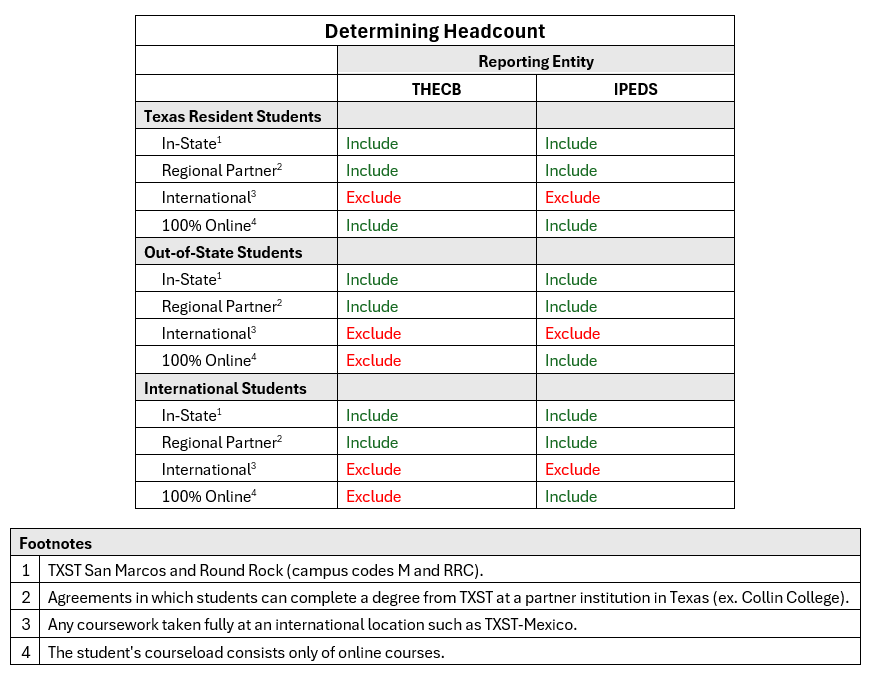Institutional Reporting
The Institutional Reporting team focuses on reporting data to provide a consistent picture of the institution to the public. The duties include completion of mandated reports at the system, state, regional, and federal level along with responding to external requests related to data needed for accreditation, guidebooks, and ranking surveys. Information reported can include admissions, applications, enrollment, and degrees awarded, among other data points.
Who We Report To
Primary Agencies & Stakeholders
- Texas Higher Education Coordinating Board (THECB): Ensures compliance with state education goals and allocates state funding.
- U.S. Department of Education (DOE): Collects data for national reporting, such as through the Integrated Postsecondary Education Data System (IPEDS), to monitor trends in higher education.
- University Leadership: Uses reports to make strategic decisions about enrollment, resource allocation, and student success initiatives.
- Texas State University System (TSUS): Oversees member institutions, ensuring alignment with system-wide goals and policies, and advocates for resources and legislative support at the state level.
- External Guidebooks & Surveys: Provides rankings, benchmarking, and insights into institutional performance through platforms like U.S. News & World Report, faciliating comparisons and enhancing visibility to prospective students and stakeholders.
What We Report
Key Perfomance Indicators (KPIs)
- Enrollment Data: Includes headcounts, demographics breakdowns, and enrollment by classification (e.g., undergraduate, graduate).
- Student Outcomes: Retention, graduation rates, degrees awarded, and time-to-degree metrics.
- Course Data: Credit hours generated by subject area or department and course instructional mode.
- Faculty Data: student-to-faculty ratios and faculty workload data.
When We Report
Reporting Calendar
- Fall Census Data: Submitted by October 15th.
- Annual Reports to THECB: Primarily due in the fall.
- IPEDS Data Collection: Takes place in three cycles: fall, winter, and spring.
- Texas State University System (TSUS): Due in fall, spring, and summer.
- External Guidebooks & Surveys: Deadlines vary but are commonly in the fall.
Timely Reporting is Critical: Missing deadlines can impact funding and accreditation status.
Why We Report
Purpose of Reporting
- Funding Allocations: Determines the level of state funding we receive through formula funding, which is tied to student enrollment and credit hour generation.
- Accountability: Demonstrates compliance with state and federal regulations, ensuring transparency and trust.
- Strategic Improvement: Empowers data-informed decisions that enhance student success, drive program development, and support the university's strategic initiatives.
- Recognition: Illustrates our university's status compared to other institutions of higher education, such as Carnegie Classifications.
More information regarding our institution's characteristics and classifications can be found here.
How We Report
Reporting Process
- Data Collection: Data is extracted from the student information system (Banner) at key census dates.
- Validation: Data is reviewed for accuracy through audits and error-checking tools.
- Submission: Finalized reports are submitted using state and federal reporting systems like CBM Reporting Portal and IPEDS.
FAQs
-
What is Census Date?
The Census Date, also called the Official Reporting Date (ORD), is when public higher education institutions record enrollment which becomes the official enrollment used in state reporting and student financial aid eligibility. For fall and spring semesters, it’s the 12th class day; for summer sessions, it’s the 4th class day.
- The Registrar’s office must be open on this day to allow students to drop or withdraw from classes.
- Preliminary enrollment refers to enrollment numbers prior to the Census Date for that semester.
Steps in the Process
- A “snapshot” is taken of enrollment on Census date that serves as preliminary enrollment numbers.
- The preliminary enrollment numbers are then verified against faculty rosters to ensure accuracy.
- Once numbers are validated, the enrollment numbers are then reported to the Texas Higher Education Coordinating Board (THECB).
- THECB certifies the enrollment and state funding is calculated using certified enrollment numbers.
-
What is Formula Funding?
Formula funding is a method used by state governments to allocate funding to public institutions of higher education based on quantifiable metrics. For universities in Texas, formula funding is determined primarily by student credit hours (SCH) and full-time equivalent (FTE) enrollment during a base period.
In short, it links the amount of money an institution receives from the state to the number of students it serves, the credit hours they generate, and the type of programs they are enrolled in. This ensures that institutions are compensated fairly for the resources required to educate their students.
For more information on Formula Funding, visit the Formula Funding webpage.
-
How is Headcount determined?
Headcount is generally referenced when reporting student enrollment numbers. Headcount is defined as the unduplicated count of individuals. Whether or not a student is reported depends on a number of factors such as, student residency status and the entity requiring the reporting. Although a student may not be counted for reporting purposes, they may be counted for general enrollment purposes, and vice versa.

-
What are Carnegie classifications?
The Carnegie Classification of Institutions of Higher Education is a framework for categorizing colleges and universities in the United States based on their research activity, degree offerings, and institutional mission. Established in 1970 and widely recognized as the leading standard in higher education, these classifications help identify an institution’s level of research intensity and educational focus, while also providing benchmarks for funding opportunities, strategic planning, and national recognition.
For more information about our university's current classification, visit the Institution Characteristics webpage.
